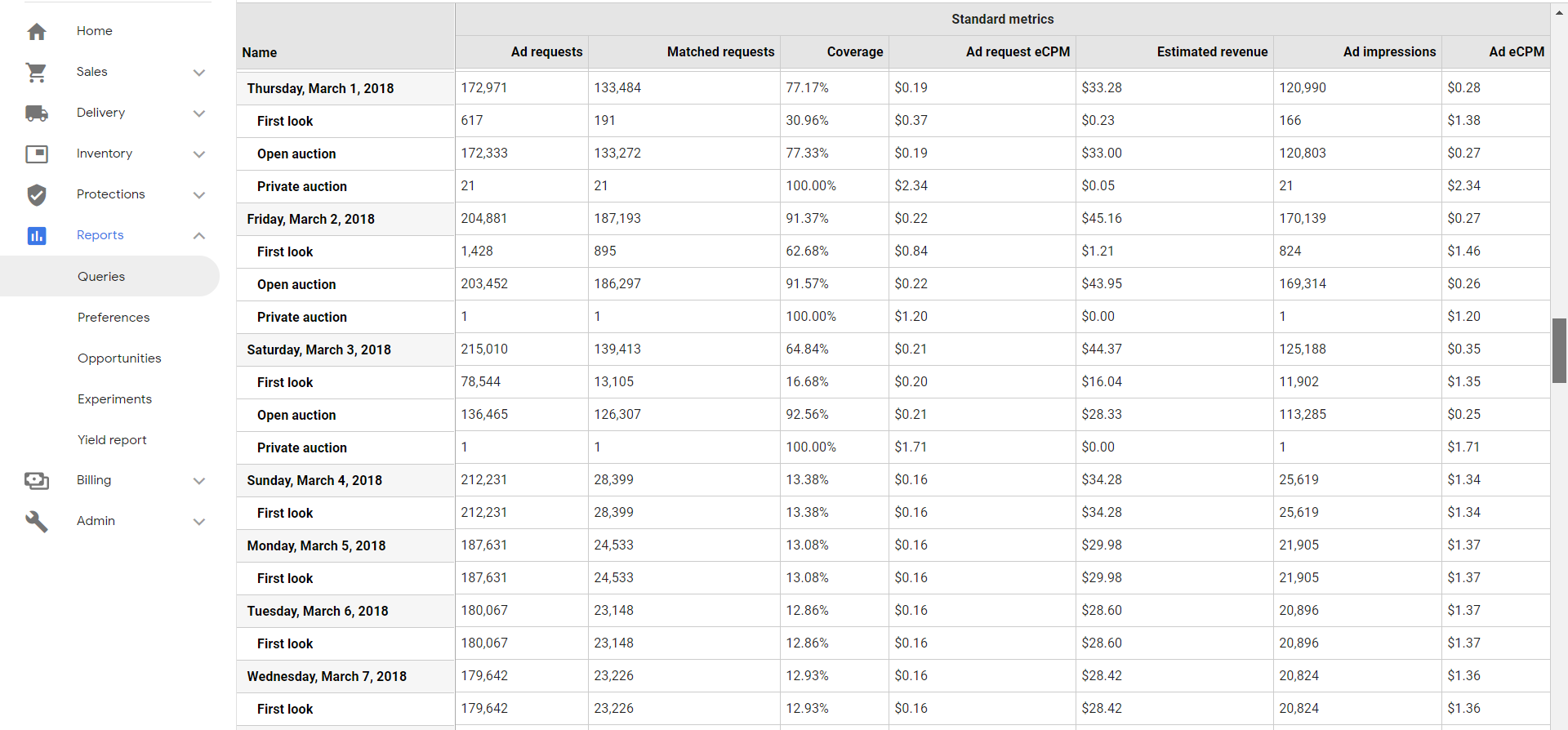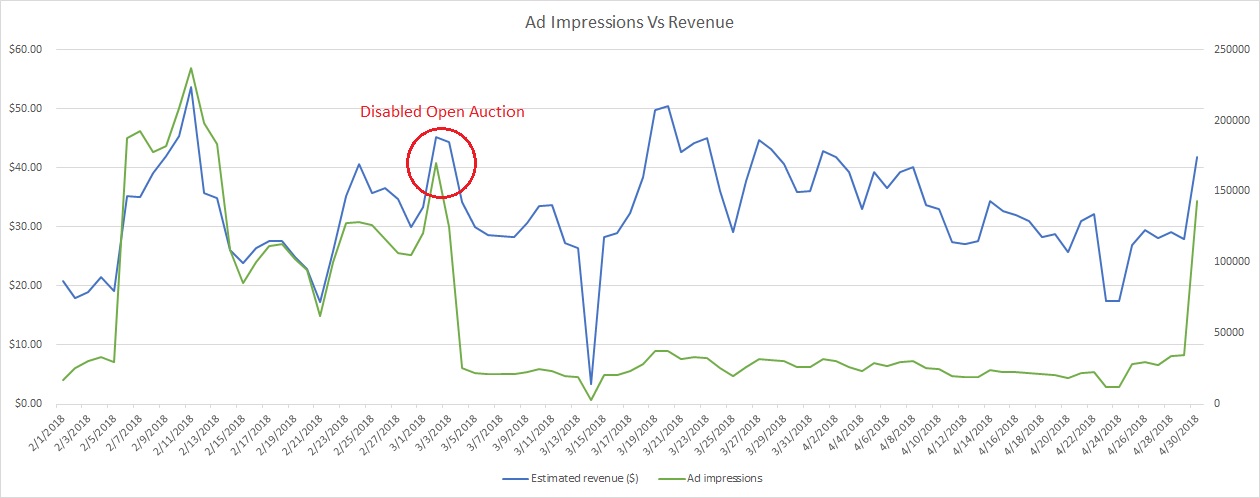Part of “Five Experiments to Understand Google Adx Better”
To understand open auctions better, it is important to have a bit of background knowledge on DFP’s Dynamic Allocation and its line-item priority flow.
In Google Ad Manager (formerly, Google DFP), there are different types of line-items from which Ad Manager will decide which impression to prioritize first and each of this line items have a priority or type associated with them. The flow will sequence as follows: Sponsorship (Line Item Priority 4), Standard (Line Item Priority 6 to 10), Network (Line Item Priority 12), Bulk (Line Item Priority 12), Price Priority (Line Item Priority 12), Ad Exchange (Line Item Priority 12), House (Line Item Priority 16) etc.
Line item type = ‘Sponsorship’ will be a goal based line item and Publishers will always have to specify a goal in percentage of total impressions. Similarly line item type = ‘Standard’ will have an option to specify goal in absolute numbers in terms of either impressions, clicks or viewed impressions. Since both Ad Manager (DFP) and Ad Exchange are products of Google, and if your Ad Exchange account is linked to Ad Manager, you will have a line item type = ‘Ad Exchange’ which will compete with all type of line items. Ad manager will have feedback from every bid request that was sent to Ad Exchange on what is the maximum CPM that Ad Exchange is bidding on a particular Ad Request and if this CPM is higher than the CPMs given by any eligible line items, Ad Exchange gets a chance to show an ad for that ad request. Now, for Ad Manager to know the maximum CPM that Ad Exchange can bid, Ad Exchange runs an auction and the highest bid will be returned to Ad Manager. Ad Exchange calls this auction as Open Auction. Meanwhile Ad Manager also makes sure that the goal that was set should be met for Sponsorship and Standard type of line items. This whole process is called Dynamic Allocation.
Now what happens if an ad request is not available for Open Auction? That is, when your sponsorship or standard value CPM is too high that open auction cannot beat it (that’s what happens most of the time for for direct sold inventory). Google introduced ‘First Look’ to beat the odds! First Look allows preferred access to inventory for select buyers in Ad Exchange. These buyers have the opportunity to buy any inventory ahead of your reservation (direct) inventory, as long as they meet your selected floor prices. So, as the name suggests, Ad Exchange buyers will have ‘First Look’ access at those requests before guaranteed line items. Publishers can set separate Pricing Rules for First Look requests and they work similar to Open Auction pricing rules and have the same flexibility in terms of targeting.
But not all requests are eligible for First Look. For an ad unit, to be eligible for First Look, there should be either guaranteed line items running or that particular ad unit is completely disabled from open auction. If any ad unit match these conditions, which is, if Google Ad Manager knows that a piece of inventory is not available in Open Auction, then by default it is eligible for First Look. First Look will have very high CPMs when compared to Open Auction.
So what if you don’t have reservation line items running and still want to make your ad unit eligible for First Look? We carried out this experiment by removing one ad unit from Ad Exchange Line item and making it eligible for First Look to see how it behaves and voila, the results were surprisingly pleasant! So we did it for more ad units; some ad units worked exceptionally well and some ad units performed, well.. meh!
When you do this experiment, it is not only about Ad Exchange or First Look but about how to smartly traffic every ad request on your website. For example, we conducted the following experiment on one of our ad units:

As you can see in the above picture, we completely stopped Open Auction from 4th of March on an adunit and made all the ad requests eligible for First Look. We expected the adexchange revenue on the adunit to drop, but interestingly First Look was giving more or less, the same revenue consuming much lesser impressions!

As you can see from the above picture, after stopping Open Auction, First Look was taking 75% lesser impressions and earning nearly 10% better revenue than the Open Auction. Best part is – you can now utilize those 75% of the impressions for other campaigns. Our line-items were setup to make sure no ad request is going unfilled. Even if your low priority line-tiems fill them at half the CPM as compared to your previous (prior to this experiment) open auction CPM, you will be having a huge upside. You can do the math. So the point here is, you know you’re having an upside when your overall ad request CPM increases and not just Ad Exchange Ad CPM or Ad Request CPM.
Optimization plays an important role here too. Sometimes your Ad Exchange ad request CPM seems to be going down but your overall Ad Request CPM maybe going up or vice versa. So you have to analyse carefully whether you’re having a great upside or just an illusion. The catch is to keep a good eye on Ad Exchange Ad Request CPM.
Overall, this is a great experiment to run as its easy and you get to learn a lot about how Ad Exchange behaves. Tell us if you have tried something like this before and the results you have seen. If not, do give this a try and let us know your thoughts on the same.
Our last post in this series coming out next week is “Can we route passback ad requests to Google first-look and what is the impact?” If you found this post useful, please don’t hesitate to subscribe to our blog!
Author
Vinay B Rao
Senior Business Analyst, Tercept

0 Comments Leave a comment